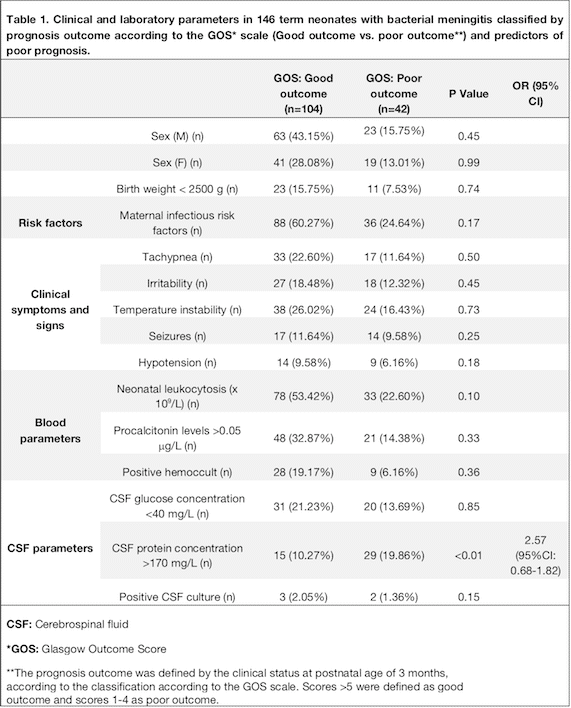
Elevated Cerebrospinal Fluid Protein Concentration as a Predictor of Poor Outcome in Neonates Diagnosed with Bacterial Meningitis
2Faculty of Medicine, Universidad Católica de Santiago de Guayaquil, Ecuador
3Department of Neonatology, Hospital de Niños Dr. Roberto Gilbert Elizalde, Ecuador
Background: Despite the efforts made to prevent infections within the neonatal period, meningitis continues to cause high rates of morbidity and mortality in this stage. Early recognition of patients diagnosed with neonatal bacterial meningitis at risk of poor prognosis could be useful to provide appropriate management and therapeutic options.
Objective: The aim of the study was to determine the factors of poor prognosis in patients with neonatal bacterial meningitis.
Methods: Observational retrospective study of 146 term infants diagnosed with bacterial meningitis admitted through the emergency department of Hospital Roberto Gilbert Elizalde from January 2013 to December 2016 in Guayaquil, Ecuador; which met the inclusion criteria. The neurological functional status of the patients was evaluated 3 months later after the day of discharge using the Glasgow Outcome Scale (GOS). Multivariate logistic regression analyses were performed to assess the relationship between clinical characteristics, laboratory findings and poor prognosis. The parameters considered were: Sex, low birth weight, maternal infectious risk factors, tachypnea, irritability, temperature instability, hypotension, seizures,neonatal leukocytosis, elevated procalcitonin levels in peripheral blood samples, positive hemoccult, low cerebrospinal fluid (CSF) glucose concentration, high CSF protein concentration and positive CSF culture. Poor prognosis was defined as GOS score <5.
Results: Patients were divided into two outcome groups: Good prognosis (n= 104, 72.23%, GOS = 5) and poor prognosis (n= 42 cases, 28.76%, GOS= 1-4). The results of the multivariate logistic regression analyses are summarized in Table 1. High CSF protein concentration, defined as > 170 mg/dL, was associated with poor prognosis [P = <0.01, OR = 2.57 (95% CI: 0.68-1.82)], found in 19.86% (n=29) patients who belonged to this group.

Conclusion: Protein concentration in the CSF of patients associated with poor outcome was significantly higher. Therefore, we concluded that high CSF protein concentration may predict poor prognosis in neonates with bacterial meningitis.
Powered by Eventact EMS